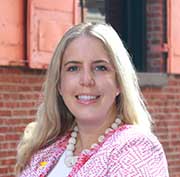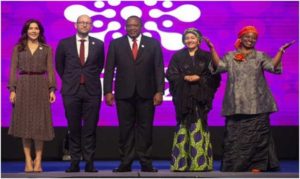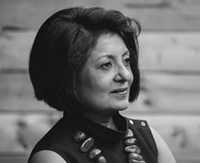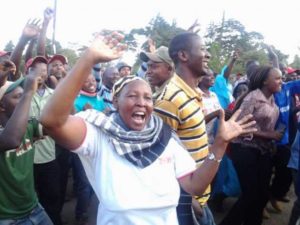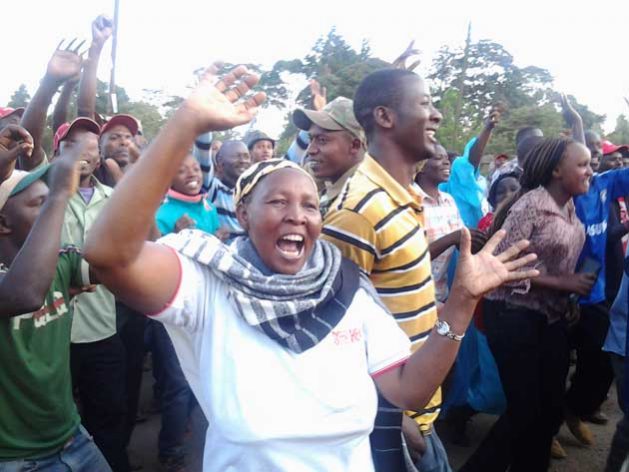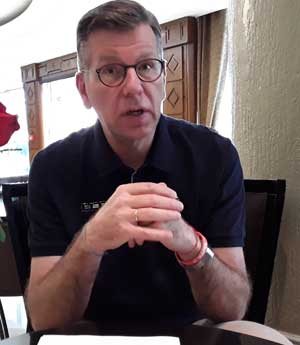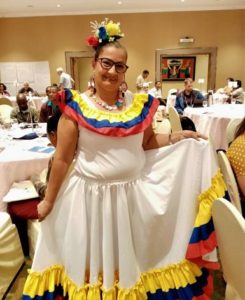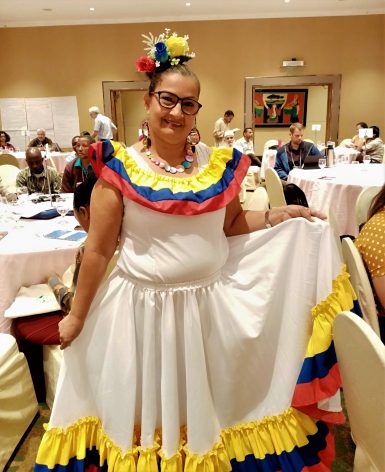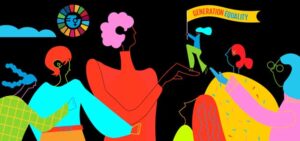
Civil Society, Featured, Gender, Gender Violence, Global, Headlines, Human Rights, Poverty & SDGs, Sustainability, TerraViva United Nations
This article has been co-authored and signed by 49 UN women Ambassadors*
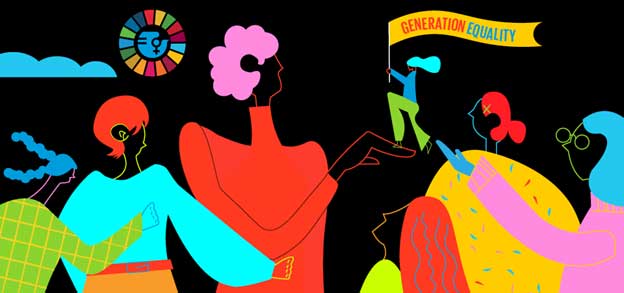
UN Women announces the theme for International Women’s Day, 8 March 2021 (IWD 2021) as, “Women in leadership: Achieving an equal future in a COVID-19 world. Credit: UN Women/Yihui Yuan
– March, women’s history month, closes with the Generation Equality Forum in Mexico and against the background of significant setbacks on the empowerment of women caused by the COVID-19 pandemic.
From our seats in the General Assembly and our screens at home we have seen it growing: the increase in deaths; gender-based, including intimate partner, violence; abuse of women and girls who speak out; the widening of the gender gap for access to digital technologies; the loss of jobs, the decrease of women’s participation in public life and decision-making; disrupted access to essential health care; increase in child marriage; and the diminished access to education.
Day by day in this yearlong battle against the pandemic we have seen how women are impacted twice: first by the virus, and then by its devastating secondary effects.
We are 49 women ambassadors representing countries from all regions of the world, and we believe that such a reality is simply intolerable. Here, we tell that story and what needs to be done to urgently recover the hard-won gains of recent years.
The COVID-19 crisis has a woman’s face.
The face of women nurses, doctors, scientists, care-givers, sanitation workers, and of those leading the response to the pandemic. Women are on the front line: As leaders delivering effectively with vision and care.
But also, as victims of structural vulnerabilities and of violence and abuse.
The “shadow pandemic” of exploitation and abuse, including domestic and intimate partner violence, should be a jarring wake-up call to us all. The latest WHO data show that 1 in 3 women experience intimate partner violence during their lifetime, while the UN reports that women with disabilities have four times the risk of experiencing sexual violence in comparison to women without disabilities.
Women will also bear the heaviest toll of the socio-economic impact of the pandemic because they often carry the responsibility for unpaid dependent care and are over-represented in jobs most affected by the crisis – hospitality, tourism, health, and trade.
The lack of women’s participation in society threatens to delay the achievement of the Sustainable Development Goals by 2030. Politically-motivated gender-based violence online and offline is a barrier to women’s ability to participate fully and equally in democratic processes.
Moreover, the persistently high rate of grave violations of women’s rights worldwide is appalling.
Against this background, this March, the UN Commission on the Status of Women (CSW) focused on two issues: fighting gender-based violence, and scaling up women’s full and effective participation at all levels and in all sectors.
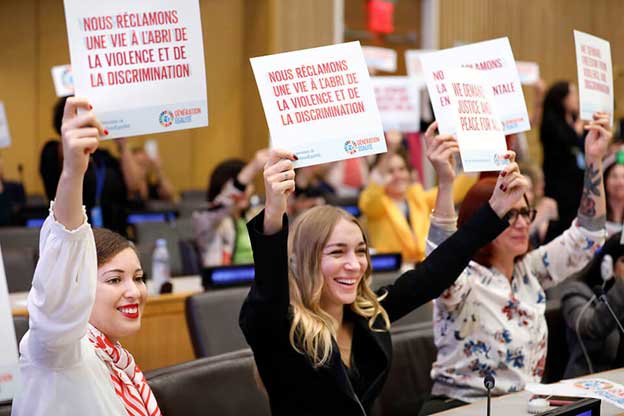
“Gender equality: From the Biarritz Partnership to the Beijing+25 Generation Equality* Forum”, hosted by France and Mexico ahead of the 74th session of the UN General Assembly, 2019. Photo: UN Women/Ryan Brown
Meaningful participation of women in politics, institutions and public life is the catalyst for that transformational change, which benefits society as a whole. Only four countries in the world have a parliament that is at least 50% women.
Worldwide only 25% of all parliamentarians are women. Women serve as heads of state or government in only 22 countries today, and 119 countries have never had a woman leader.
According to UNESCO, 30% of the world’s researchers are women. While 70% of the health and social care workforce are women, they make up only 25% of leaders in the global health sector.
Current projections show that if we continue at the current rate, gender equality in the highest positions of power will not be reached for another 130 years. These figures speak of unacceptable barriers and bottlenecks that continue to block women’s participation.
As the Secretary-General of the UN says, parity is ultimately a question of power. As women, we are often reluctant to use this word. But as women ambassadors at the UN, representing countries from around the world, it is a word we cannot and will not be too shy to use.
Power is not an end in itself: it is the power to change things, to act and have equal opportunities to compete. While as women Ambassadors we are still under-represented here in New York – only 25% of Permanent Representatives are women – we are committed to being a driving force to shift mindsets. We are long past the point where women should have to justify their seat at the table.
A large body of research and scientific literature provide unequivocal evidence of the value of integrating women’s perspectives in decision-making. Countries led by women are dealing with the pandemic more effectively than many others.
Peace processes and peace agreements mediated with the active participation of women are more durable and comprehensive. Yet women make up only 13% of negotiators, 6% of mediators and 6% of signatories in formal peace processes.
When women have equal opportunities in the labor force, economies can unlock trillions of dollars. Yet last year, the International Labor Organization found that women were 26% less likely to be employed than men. In 2020 only 7.4% of Fortune 500 companies were run by women.
Worldwide, women only make 77 cents for every dollar earned by men, while the gender gap in internet access grew from 11% in 2013 to 17% in 2019, reaching 43% in the least developed countries.
The so-called “motherhood penalty” pushes women into the informal economy, casual and part-time work. After slow but steady gains over the last few decades, COVID-19 has forced millions of women out of the formal labor market.
The solution to this will not occur spontaneously nor by magic. We need positive action. We need data disaggregated by sex and age so we can better analyze the scope of the problem; we need targeted policies and earmarked investments.
We have to strengthen support services for survivors of abuse, as well as prevent violence and end impunity. And we need to reduce the digital divide and promote access for women to information and public life.
We must rebalance the composition of decision-making bodies. We need to integrate gender into the design and implementation of recovery plans. We need to ensure the availability, accessibility, quality, and continuity of health services for women, including sexual and reproductive health services.
Social protection programmes should be gender responsive and account for the differential needs of women and girls. We need to promote access for women to decent work and overcome the choice between family and work that is too often imposed on women. Women should have targeted support for entrepreneurship and investment in education that guarantees equal access.
This should not only start with women, but with girls. Getting more girls into school, including back into school following the pandemic, improving the quality of education girls receive, and ensuring all girls get quality education: this will enable female empowerment and gender equality, which will be critical for the effective participation of future generations of women. We must make justice accessible to all women and end impunity for sexual violence.
This will also require role models. As women ambassadors, we bear testament to young generations of girls and women across the world showing that, like us, they can make it. No career and no goal are off-limits for them, as they are in all their diversities, nor beyond their capacities.
Parity is not a zero-sum game but a common cause and a pragmatic imperative. Men can be and are our allies in achieving parity. We look forward to continuing momentum on accelerating progress on achieving gender equality through the Generation Equality Forum and its Action Coalitions. Let us together set the stage for an inclusive, equal, global recovery. Let us make this generation “Generation Equality”.
There’s no more time to lose. We’ve lost enough to COVID already.
*List of participating Ambassadors, (including one Chargé d’affaires, a.i.) who co-authored this article (and the day they took office)
AFGHANISTAN H.E. Mrs. Adela Raz (8 March 2019); ALBANIA H.E. Ms. Besiana Kadare (30 June 2016); ANDORRA H.E. Mrs. Elisenda Vives Balmaña (3 November 2015); ANGOLA H.E. Ms. Maria de Jesus dos Reis Ferreira (21 May 2018); ARGENTINA H.E. Ms. María del Carmen Squeff (31 August 2020); BANGLADESH H.E. Ms. Rabab Fatima (6 December 2019); BARBADOS H.E. Ms. H. Elizabeth Thompson (30 August 2018); BHUTAN H.E. Ms. Doma Tshering (13 September 2017); BRUNEI DARUSSALAM H.E. Ms. Noor Qamar Sulaiman (18 February 2019); BULGARIA H.E. Ms. Lachezara Stoeva (17 February 2021); CHAD H.E. Ms. Ammo Aziza Baroud (11 December 2020); CZECH REPUBLIC H.E. Mrs. Marie Chatardová (2 August 2016); DOMINICA H.E. Ms. Loreen Ruth Bannis-Roberts (22 August 2016); EL SALVADOR H.E. Mrs. Egriselda Aracely González López (21 August 2019); ERITREA H.E. Ms. Sophia Tesfamariam (5 September 2019); GREECE H.E. Ms. Maria Theofili (13 September 2017) ; GRENADA H.E. Ms. Keisha A. McGuire (12 April 2016); GUYANA H.E. Mrs. Carolyn Rodrigues-Birkett (2 October 2020); HUNGARY H.E. Ms. Zsuzsanna Horváth (16 February 2021); IRELAND H.E. Ms. Geraldine Byrne Nason (18 August 2017); ITALY H.E. Ms. Mariangela Zappia (13 August 2018); JORDAN H.E. Ms. Sima Sami Bahous (22 August 2016); KYRGYZSTAN H.E. Ms. Mirgul Moldoisaeva (12 April 2016); LEBANON H.E. Ms. Amal Mudallali (15 January 2018); LITHUANIA H.E. Ms. Audra Plepytė (18 August 2017); MADAGASCAR Ms. Vero Henintsoa Andriamiarisoa (Chargé d’affaires, a.i.); MALDIVES H.E. Ms. Thilmeeza Hussain (21 May 2019); MALTA H.E. Mrs. Vanessa Frazier (6 January 2020) ; MARSHALL ISLANDS H.E. Ms. Amatlain Elizabeth Kabua (5 July 2016); MICRONESIA H.E. Mrs. Jane J. Chigiyal (2 December 2011); MONACO H.E. Ms. Isabelle F. Picco (11 September 2009); MONTENEGRO H.E. Mrs. Milica Pejanović Đurišić (21 May 2018); NAURU H.E. Ms. Margo Reminisse Deiye (27 November 2020); NETHERLANDS H.E. Ms. Yoka Brandt (2 September 2020); NORWAY H.E. Ms. Mona Juul (14 January 2019); PANAMA H.E. Ms. Markova Concepción Jaramillo (16 November 2020); POLAND H.E. Ms. Joanna Wronecka (19 December 2017); QATAR H.E. Sheikha Alya Ahmed Saif Al-Thani (24 October 2013) ;RWANDA H.E. Mrs. Valentine Rugwabiza (11 November 2016); SAINT VINCENT AND THE GRENADINES H.E. Ms. Inga Rhonda King (13 September 2013); SLOVENIA H.E. Ms. Darja Bavdaž Kuret (18 August 2017); SOUTH AFRICA H.E. Ms. Mathu Theda Joyini (22 January 2021); SURINAME H.E. Ms. Kitty Monique Sweeb (19 June 2019) ; SWEDEN H.E. Ms. Anna Karin Eneström (6 January 2020) ; SWITZERLAND H.E. Mrs. Pascale Baeriswyl (26 June 2020); TURKMENISTAN H.E. Mrs. Aksoltan. Ataeva (23 February 1995); UNITED ARAB EMIRATES H.E. Mrs. Lana Zaki Nusseibeh (18 September 2013); UNITED KINGDOM H.E. Dame Barbara Woodward (2 December 2020); UNITED STATES OF AMERICA H.E. Ms. Linda Thomas-Greenfield (25 February 2021)

